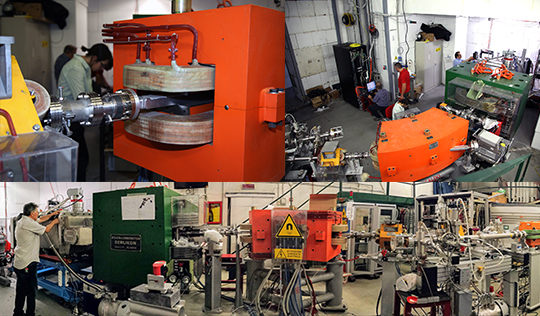 A very thin diamond target to capture the dark photon by detecting it in 1 million particle collisions per second. This is the heart of the PADME experiment (Positron Annihilation into Dark Matter Experiment) that will study, in search for dark matter, the interactions produced by positrons accelerated to the energy of 550 MeV from the linear accelerator (LINAC), of the National Laboratories of Frascati of the National Institute of Nuclear Physics.
A very thin diamond target to capture the dark photon by detecting it in 1 million particle collisions per second. This is the heart of the PADME experiment (Positron Annihilation into Dark Matter Experiment) that will study, in search for dark matter, the interactions produced by positrons accelerated to the energy of 550 MeV from the linear accelerator (LINAC), of the National Laboratories of Frascati of the National Institute of Nuclear Physics.
Inaugurated today, Thursday 4 October, with a ceremony to celebrate the transition from the test phase (commissioning) to the data acquisition phase, the PADME experiment will remain in operation for a few months, until the end of the first data acquisition phase (Run 1). The experiment could reveal for the first time the existence of a "new force" to which a particle called a dark photon should be associated, thanks to a small but extremely precise measuring device, able to observe the production of the dark photon in collisions of antielectrons with the electrons of the target.
The PADME experiment is based on a hypothesis advanced by some theoretical models that foresee the existence of a fifth force able to connect the dark matter with our world and that would be added to the four known fundamental forces: gravitational, electromagnetic, strong nuclear and weak nuclear. To this new fifth force, as for the other four, a messenger particle would be associated, in this case a "heavy" photon, that brings a small mass (as opposed to the ordinary photon which does not possess it. Physicists named it " dark photon ".
"The problem of dark matter is certainly one of the most important in modern physics, and INFN is deeply involved in all the great experiments, often with a leading role," said Fernando Ferroni, INFN president. "It is crucial, however, to verify less studied theoretical models, thanks to small, dedicated experiments, such as PADME, which exploit the great INFN expertise in accelerator technology" concludes Ferroni.
"PADME will use for the first time collisions of positrons on a fixed target in order to explore the content of that hidden part of the cosmos that we call dark matter" stated Mauro Raggi, spokesperson of the experiment and INFN researcher. "The possibility that there are new forces and new unknown particles is certainly a very fascinating frontier and the PADME team is very proud to participate in this venture" said Raggi.
"PADME uses a research infrastructure called Beam Test Facility (BTF) that extracts accelerated particles in the LINAC (linear accelerator) and that has been used, over the past 15 years, by the experimental physicist community for the development of new detector technologies" added Paolo Valente, co-spokesperson of the experiment. "In the future, moreover, it will be possible to use BTF also for industrial applications, for example in the field of radiation damage studies" concluded Valente.
"PADME is the best demonstration that even medium-sized laboratories, can have a high level basic physics program. Today the research of the origins of dark matter is one of the most exciting and difficult challenges and requires a multiplicity of approaches " stated Pierluigi Campana, director of the National Laboratories of Frascati.
PADME is an international collaboration involving researchers from the MTA Atomki institute in Debrecen, Hungary, where experiments have already been carried out on the dark photon and the University of Sofia, Bulgaria, which has been dealing with scintillating bar detectors. They are also members of the Cornell University, Iowa University and William and Mary College of the United States.
The sensitivity of the experiment could be much improved by using a beam of higher energy particles, for example using accelerated positrons and extracted from a synchrotron. This proposal is studied in collaboration with colleagues at Cornell University, also thanks to an exchange program financed by the Ministry of Foreign Affairs and International Cooperation.






